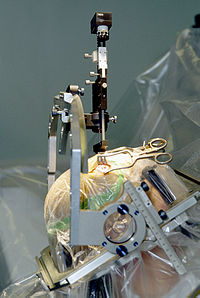
Photo from wikipedia
Complex neuro-immune-vascular interactions play key roles in the development of both neuroinflammation (an inflammatory response within the nervous system) and neurogenic inflammation (sensory nerve-released neuropeptides inducing inflammation in different tissues).… Click to show full abstract
Complex neuro-immune-vascular interactions play key roles in the development of both neuroinflammation (an inflammatory response within the nervous system) and neurogenic inflammation (sensory nerve-released neuropeptides inducing inflammation in different tissues). Both phenomena have a substantial importance in the pathogenesis of several diseases and might be targets for pharmacological interventions. Therefore, the present Research Topic was designed to collect papers on the molecular mechanisms and pharmacology of pathological processes affecting neuro-immune-vascular interfaces, focusing on neurodegeneration, stroke, headache, neuropathic and other types of pain, as well as peripheral inflammatory diseases, such as arthritis or dermatitis. In addition, interactions between the peripheral and central nervous systems have also been explored. Neuroinflammation is usually accompanied by vascular reactions, including opening of the blood-brain barrier. In the present Research Topic, Gabbert et al. (2020) describe the important role of protocadherins, especially PcdhgC3 in regulating the barrier integrity of brain microvascular endothelial cells in control and inflammatory conditions. One of the most frequent inflammatory conditions affecting brain vessels is ischemic stroke. Recanalization with tissue plasminogen activator (tPA) is the only approved agent available in this condition. The systematic review by Ye et al. (2020) identifies the possible protective effect of immunomodulators on a lethal side effect of tPA treatment, namely hemorrhagic transformation. In addition, Chen et al. (2021) found that inflammasome proteins were upregulated in neutrophil extracellular traps present in thrombi of patients with acute ischemic stroke, contributing to poor outcomes after tPA treatment. Inflammasomes were in the focus of the work of Nógrádi et al. (2020) as well. However, they studied not vascular cells, but neurons and found that peripheral nerve injury induced inflammasome activation in motoneurons. The thiazide structure oral antidiabetic diazoxide proved to be protective in this model. Interlocking of peripheral and central processes has been investigated by Lovrenčić et al. (2020) too. They found that intranasal inflammatory reactions provoke distant intracranial changes, including headache. Inflammatory reactions may affect the peripheral nervous system as well. Inflammatory neuropathies are characterized by leukocyte infiltration of peripheral nerves, demyelination and axonal degeneration. Therefore, inflammation and pain control in chronic neuropathies is essential to improve the outcomes of the disease. Somatostatin released from capsaicin-sensitive peptidergic sensory nerve endings leads to anti-inflammatory and anti-hyperalgesic actions at distant parts of the body, Edited and reviewed by: Frontiers Editorial Office, Frontiers Media SA, Switzerland
Journal Title: Frontiers in Pharmacology
Year Published: 2022
Link to full text (if available)
Share on Social Media: Sign Up to like & get
recommendations!